Intel Core Duo: AOpen i975Xa-YDG to the Rescue
by Gary Key on May 4, 2006 8:00 AM EST- Posted in
- Motherboards
Board Layout
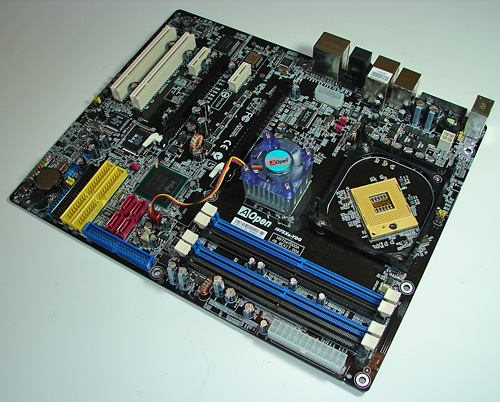
AOpen designed a very well laid out board with all major connections easily reached. The board is lacking most clearance issues and was very easy to install in a mid-size ATX case. The board features an excellent voltage regulator power design along with Rubycon capacitors that yielded superb stability and overclocking results. Here's an enhanced close-up of the capacitors area.

The DIMM module slots' color coordination is correct for dual channel setup based upon the premise of utilizing different colors for each memory bank. The memory modules are easy to install with a full size video card placed in the first PCI Express X16 slot. The 24-pin ATX power connector is located along the upper edge of the board and below the memory modules.
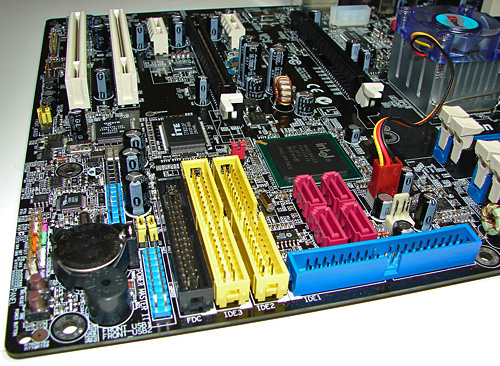
The Intel IDE port connector is the blue IDE socket located along the edge of the board and to the right of the memory modules. This port did not present any connection issues in our mid-size ATX case. The system and Northbridge fan headers are located above the IDE1 port and to the left of the Intel SATA ports.
The four Intel SATA ports are a reddish-pink color and are conveniently located below the Intel ICH7 Southbridge. The SATA ports feature the newer clamp and latch design. We found the positioning of the SATA ports to be excellent when utilizing the PCI-E slots or the Intel IDE port connector. The Intel ICH7 Southbridge does not require a heatsink in this application.
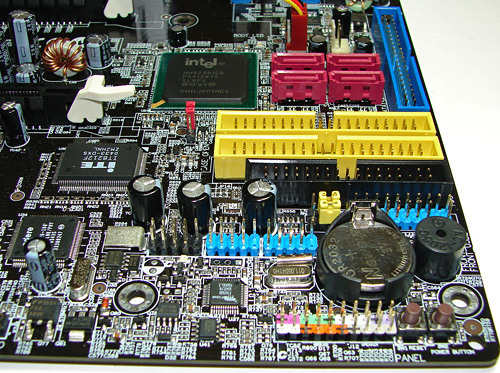
The two yellow IDE port connectors are provide by the ITE chip and are located below the Intel SATA ports. These ports did not present any connection issues in our mid-size ATX case although they could potentially interfere with the SATA ports or might cause a cable length issue in full size ATX cases.
The black floppy drive connector is positioned below the ITE IDE ports. The location of this connector is not ideal and actually the whole point of having a floppy drive connector is becoming moot with the wide spread availability of USB floppy or flash drives along with BIOS support for boot purposes.
The blue IR port is located below the floppy drive connector and above the battery. This connector is required for the Remote Control unit. Take note of the yellow jumpers; if they are not installed correctly the Remote Control unit will not operate correctly. The jumper configuration is not mentioned in the manual.
The nine pins on the black plastic base provide an additional IEEE-1394 connector; this connection is located to the left of the two additional blue USB connectors - not to be confused with the blue IR connection. The chassis panel connections are located at the bottom edge of the board below the battery. AOpen also provides onboard reset and power buttons, a feature that is greatly appreciated and very useful for boards not in a case. Last and actually least used is the clear CMOS jumper block that is a traditional jumper design located below the Intel ICH7 and to the left of the ITE IDE connectors. We did not utilize this jumper throughout our two weeks of testing this board and AOpen should be commended for their BIOS self recovery system and general board stability.
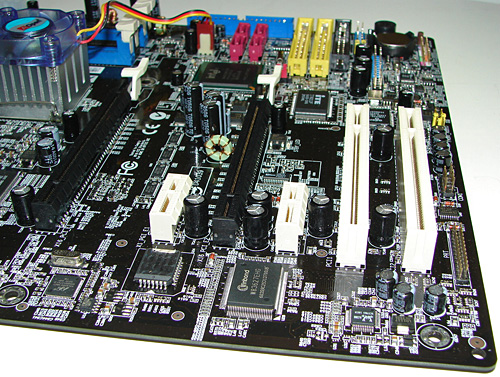
The board comes with (2) physical PCI Express X16 connectors, (2) PCI Express X1 connectors, and (2) PCI 2.3 connectors. The layout of this design offers a good balance of expansion slots for a mainstream board while providing excellent clearance space for card utilization. AOpen designed a two slot opening between the first X16 PCI-E connector and the first X1 PCI-E connector, allowing you to utilize the X1 connector with a dual slot cooling system.
The primary PCI Express X16 connector is located to the far left of the slot areas. The first PCI Express X1 connector is located next, followed by the secondary PCI Express X16 connector. The second PCE Express X1 connector is next, and then last are the (2) PCI slots. Although there are two physical X16 connectors available on the board, they operate in X8 PCI-E mode in multi-GPU or CrossFire mode.
We did not have any issues installing our EVGA 7900GTX 512MB or ATI X1900XTX video cards in the first or second X16 PCI Express slots. A dual slot card located in the second X16 connector will physically render the second PCI Express X1 slot useless. There were no issues utilizing this slot with video cards containing single slot cooling systems.
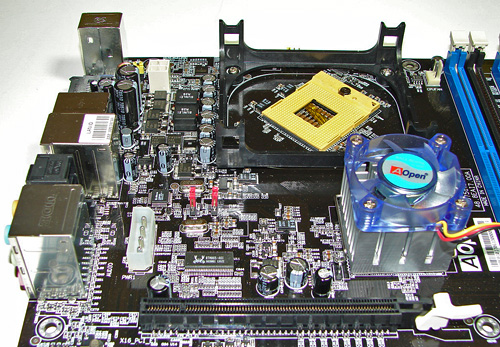
Returning to the CPU socket area, we find an ample amount of room for alternative cooling solutions. We utilized the supplied AOpen heatsink/fan but also verified a couple of Socket-478/9 cooling solutions would fit in this area during our tests. However, due to the low voltages utilized and resulting thermal output, the supplied AOpen heatsink/fan worked fine throughout our testing. The CPU socket is rotated at a 45 degree angle, which we have seen in past Pentium-M configurations.
The Intel 975X Northbridge is actively cooled with a medium sized heatsink/fan unit that did not interfere with any installed peripherals. In fact this unit kept the chipset cool enough that additional chipset voltage was not a factor in our overclocking tests. Our only concern is the lifespan of the fan but it is very quiet during operation. Our advice to AOpen is to install a more effective passive heatsink design and drop the fan as our overclock testing showed no differences between the fan operating or not.
AOpen places the four-pin 12v auxiliary power connector at the top of the CPU socket area but out of the way of aftermarket cooling solutions. The four-pin Molex power connector is located above the first X16 PCI-E connector and must be utilized for multi-GPU or CrossFire operation. This connector is located in a position that can hamper airflow with cabling that crosses directly over the CPU heatsink/fan, though power supplies with longer cables will usually allow you to route cables around the CPU.
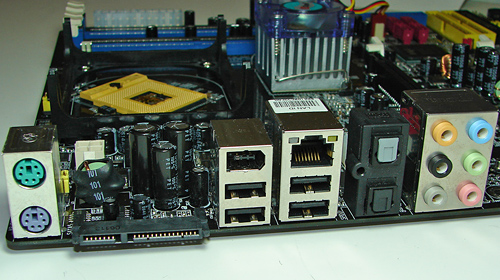
The rear panel contains the standard PS/2 mouse and keyboard ports, LAN port, and 4 USB ports. The LAN (RJ-45) port has two LED indicators representing Activity and Speed of the connection. The audio panel consists of 6 ports that can be configured for 2, 4, 6, and 8-channel audio connections. The rear panel also has two S/PDIF optical ports (In/Out), IEEE-1394 port, and a powered external SATA 3Gb/s port.
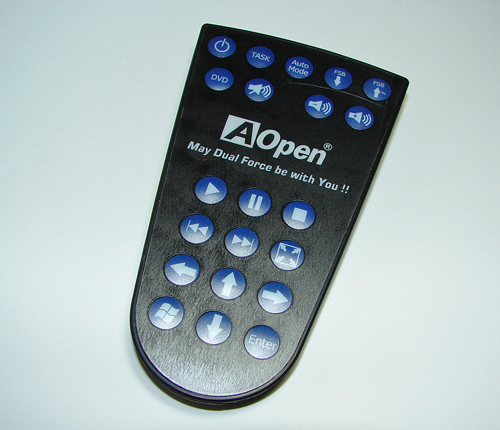
One of the more interesting options we have seen in a motherboard kit is this remote control unit from AOpen. Its main purpose is to control Windows Media Player functions but AOpen designed system on/off and FSB overclocking capability into the mix. Both of these functions proved valuable during the course of our testing, especially the FSB settings as we explored the overclocking limits of our board. (Just don't let your toddler have too much fun pressing buttons on the remote!)










81 Comments
View All Comments
snorre - Thursday, May 4, 2006 - link
What in the world are you doing?Is AT's review's getting worse and worse???
This has to be one of the worst reviews ever... comparable to those found at Tom's...
Gary... what in the world were you on when you did this review???
ANANDTECH
in our next review, we'd like to show your how an AthlonFX60 compares to a 2.8Ghz Celeron
........."as you can see, the Celeron just cannot keep up with the AMD monster, looks like intel is really going to have to pick up the pace or AMD could rule the frickin' world with this new behemoth"
For real though, did Intel pay you off for this review???
I've been a loyal Anandtecher for quite some time, and if I keep seeing reviews of this caliber, I've no choice than to delete my bookmark.
kmmatney - Thursday, May 4, 2006 - link
I wouldn't mind if you deleted your bookmark. Your post was one of the dumbest things I've ever read.Gary Key - Thursday, May 4, 2006 - link
I am replying to your post. What are you doing?
It depends on how you look at it. I am usually positive so I think the three reviews posted on our website this week are probably some of the best you will read. However, I really did enjoy a mobile hard drive article at Tech Report this week.
How exactly is this one of the worst reviews ever? Really, I would like to know so I can address any shortcomings in future articles? My personal grade was a B+ to A-, the article really needed the 3dsmax 7 benchmark (still working on but our Opteron/Asus combo barfs on it during overclocking, trying a new load tonight), a Photoshop benchmark would have been nice, Oblivion benchmark is coming, a Sim or RTS benchmark would be great, and thermals will be posted once we come to a decision on what numbers to post.
After seeing the other reviews on this board I see very little real world application benchmarks for every option on the board, the lack of overclocking, and CrossFire is totally absent. Tell us what we can do better, we are listening. :)
I was on my Herman Miller Mirra for about 140 hours while completing this article. :)
That is a very good idea, actually the Celeron would win if we only tested power consumption, thermals, and pricing. I guess Intel wins this battle without much of a fight and I can complete this article in a few hours instead of weeks. ;-)
Actually, Intel declined our request for a Duo Core CPU for this article. I purchased it from NewEgg directly and will have to explain to the wife why I spent $327 to get insulted.
We hope you continue to be a loyal reader and while I disagree with your assessment of our article, I do respect your right to an opinion.
snorre - Friday, May 5, 2006 - link
Commenting on your no-good review of course.
As a review of AOpen i975Xa-YDG I guess it's all ok, but the comparison of Core Duo to Opteron is really hopeless IMHO. What were you thinking?! Just a brief look at your test setup made me really mad, the AMD box is totally inadequate set up to say the very least. If you're going to do a desktop processor comparison, then please do it properly with the best possible desktop processors, motherboards/chipsets, memory and graphics cards currently available. Just to get you started; Opteron 175, Asus A8R32-MVP, OCZ EB DDR PC-4000 Platnium Edition and ATI X1900 CrossFire are hardly the best setup the AMD platform can provide today.
And with regards to comparing overclocked processors; C'mon give us a break!
I'm starting to wonder if you set up the mysterious AMD box yourself when you published all those fishy Conroe benchmarks from IDF earler this year... *sigh*
That was a joke if you didn't get it. At first glance your review reminded me about Kristopher Kubicki's hopeless comparison of Intel Xeon Nocona 3.6GHz to AMD Athlon 64 3500+.
What's next? Anandtech's server shoot-out: Intel Woodcrest vs. AMD Sempron? That'd be really interesting....NOT!
Thank you, I do too. Still, I hope you shape on your benchmarking in the future. Anandtech should know better than to do benchmarketing like this, unless you loose your credibility as an independent review site IMHO. Be critical, provide us with facts and not marketing bullshit, please!
Gary Key - Friday, May 5, 2006 - link
Please tell us what possible platform changes could have been made in order to keep the comparison fair? This was a motherboard review, different than what we normally do with the facts as to our component choices were explained thoroughly in the article, and not a CPU comparison although it lended itself well to that point in the end. If I were doing a CPU comparison, it would have been FX60+ versus Conroe E6800, and lets just say you would have been even more upset with the results regardless of board, video, or memory choices. ;-)
In order-
1. What AMD processor would you have used for the stock clock settings? The T2400 in our review runs at 1.83GHz and is a dual core design, you must stay at this CPU speed for a fair comparison.
2. What AMD motherboard would have been your choice? It has to have CrossFire capability in order to match the specs on the AOpen board. There are only about eight choices and they all perform within a couple of percent of each other.
3. What 1GB x 2 DDR memory kit would you have chosen? Remember our memory choice for the Intel platform runs at 3-3-3-8 at stock and at 4-4-4-15 at the 11x255 setting. Our OCZ is in the top two choices of 1GB DDR sticks, in our testing it ran at 3-3-2-7 1T at stock and at 3-3-3-7 1T at the 11x255 settings, giving it an advantage over the DDR2 system. A CAS2 or CAS2.5 setting would have improved the AMD platform scores at the stock settings but remember, we are equalizing all items within the platform for testing and these settings must pass our benchmark tests.
4. What ATI card or otherwise would you have chosen for CrossFire testing? I am really interested in this one as the last time I checked the 7900GTXs did not have official SLI support in the Intel board. It is a toss up in most situations between the two cards anyway, what other cards currently on the market are better?
5. What AMD CPU would you have chosen for running at the 11x multiplier? Remember, it must be 11x and a dual core.
Why, we always show overclocked results in our motherboard comparisons. Are you just upset with results?
I never published any Conroe benchmarks or attended IDF this year.
I did get, my response was a joke also. Did you get it?
We are an independent review site. I was critical in the review about the board's shortcomings, took shots at NetBurst technology several times, and briefly touched on the Core Duo issues with 64-bit extensions even though this was not a CPU article. The results presented are facts, thoroughly reviewed, and retested over a dozen times. Our results are based on these facts, in fact we used numerous real world applications in this review and stayed away from presenting strictly synthetic benchmarks which obviously favored Intel. I cannot begin to understand why you believe this was marketing b.s. as we real world applications, equal platforms, default settings, and presented the results as fairly as possible. Intel was never involved, never provided review materials, as this review was about the AOpen i975Xa-YDG and its ability to work as advertised. It was a fair review, end of subject.
I was just as surprised as anyone else with the results. The numbers speak for themselves, if you do not like them there is nothing I can do about it. If these results upset you then I highly suggest you take some Prozac before this July. ;-)
In the end we will have to agree to disagree. However, if you still think we are spewing marketing propaganda then visit http://www.xtremesystems.com/index.php">XS- Your Source for Conroe/Yonah Benchmarks and see what users are doing with these chips. These same users are some of the most avid AMD enthusiasts on the planet. Thank you. :)
snorre - Friday, May 5, 2006 - link
Athlon 64 FX-60 downclocked to 1.8GHz, although I don't see why as I find comparing clock frequencies across microarchitectures totally irrelevant.
I don't see why it has to have CrossFire for? To really match the specs on the Asus board the AOpen board also has to have ATi CrossFire Xpress 3200 chipset and it don't. DFI Lanparty UT NF4 SLI-DR Expert would be my AMD motherboard of choice and I'd DFI Lanparty UT NF4 SLI-DR Expert and I'd have tested it with a single nVIDIA GeForce 7900GTX 512MB GDDR3 graphics card on both boards (no SLI).
I'd have used 2 x Crucial PC4000 BallistiX Tracer 1024MB running 2.5-2-2-5 1T @ 250MHz HTT. Using slower memory would give Core Duo's faster shared cache a unfair advantage in my opinion.
If you're so interested in testing CrossFire I'd do it on the nForce4 SLI board mentioned above, but I'm more interested seeing single card benchmarks like 7900GTX.
Athlon 64 FX-60 as you can set the multiplier to anything you like, but as I said I find this requirement strange because I find comparisons of clock frequencies across microarchitectures totally irrelevant.
I'm only upset with what I regard as a flawed test setup that in turn made the results totally uinteresting to me.
Good, I was a bit unsure there for a second ;-)
Good to hear it, and I hope it will stay that way in the future too. Sorry for being so harsh, on second thought it seems like I mistaked you for just another Kristopher Kubicki clone (he got a few bad reviews on his record FYI).
Gary Key - Friday, May 5, 2006 - link
How would an FX-60 make a difference? I can try it, but the differences in previous testing with an FX-60 down clocked to match an Opteron showed zero differences (same memory controller). If you are comparing CPU architectures then performance comparisons at like clock speeds is of great value to determine design advantages. AMD's greatest advantage with the Athlon64 series has been their performance per watt when compared to the Intel Pentium 4 series. A level that after several years Intel is just now equaling. In terms of product histories, this is an incredible feat for AMD.
It needed to be CrossFire capable as the AOpen board fully supports CrossFire, a feature on the board that was fully tested and compared to another CrossFire capable board. I have not seen any performance advantages of the DFI Lanparty UT NF4 over the Asus A8R32 at stock speeds, in fact the Asus board commands a 2%~3% performance advantage across the board in testing. This is no surprise as DFI forgoes stock level performance in order to ensure they have the highest performing boards when overclocking. As part of our test suite, we test all boards with the latest GPU options. I tested both boards with an EVGA 7900GTX and had the same results (percentage differences) in the benchmarks. Any thoughts that the NVIDIA card would make a difference is incorrect. In fact, on the HL2-LC scores the AMD platform went from a tie to a 4% disadvantage.
I ran the OCZ at 2.5-3-2-7 1T on a couple of benchmarks at the stock settings, had about a 1% positive effect at the stock settings, same for running some new Corsair memory on the AOpen board at 3-2-2-8, even trade. However, I did not run any benchmarks at the overclocked settings yet.
CrossFire does not work on the NF4 boards without a hack which causes a performance decrease of up to 8% in most cases so this option is not viable.
Flawed because the numbers did not go in AMD's favor? For an article that was uninteresting you certainly have made an incredible amount of statements about it. :)
We all will have bad reviews at one time or the other. :) Cheers......
snorre - Saturday, May 6, 2006 - link
For one thing, it's the best desktop processor AMD have to offer right now. Secondly, it's a far better overclocker since its memory controller works flawlessly with DDR500 memory at the exact same timings as DDR400 memory. Thirdly, it dosen't have any multiplier lock.
I really doubt that a board based on ATi CrossFire Xpress 3200 performs better on average than a board based on nVIDIA nForce4 SLI X16. DFI Lanparty UT NF4 SLI-DR Expert is currently regarded by many enthusiasts as the best nVIDIA nForce4 SLI X16 based board out there, but if you don't like it then I'd suggest Asus A8N32-SLI Deluxe instead.
With a proper nForce4 SLI X16 board, Athlon 64 FX-60 and Crucial PC4000 BallistiX Tracer 1024MB running 2.5-2-2-5 1T @ 250MHz HTT there should be a noticable difference. If not something must be seriously wrong with your test methodology.
I don't know the OCZ memory or the board you used, but if you only see 1% performance improvements going from 3-3-3-8 1T to 2.5-3-2-7 1T then something seriously must be wrong. I'd expect 3-5% performance increase on average depending on memory intensive benchmarks, e.g. RealStorm Global Illumination Benchmark 2006. However, I'd strongly suggest that you run the OCZ memory at DDR500 speeds with the best possible timings. If it can't handle it, then switch to Crucial PC4000 BallistiX Tracer 1024MB sticks instead.
No, because I still question your test setup. This one's for you:
The only genuinely objective benchmark is the one left on a person's trousers when they sit on a bench that has just been painted.
I'm not your average reader either, but hey your average reader dosen't bother commenting your articles either right? :)
Yeah, after all it's human to fail. Quite understandable as long as we learn from our failures, else we're condemned to repeat history. Fool us once shame on you, fool us twice shame on us.
Cheers! :)
Gary Key - Saturday, May 6, 2006 - link
Our Opterons have the same E6 memory controller as our FX60. The FX60 down clocked to 9x204 or 11x255 does not generate any different scores. It does not overclock any better than our Opterons on air or water. In fact our Opteron 170 overclocks to 2.90GHZ on air and 3.05GHz on a cheap water system. The FX60 does 2.82GHz on air and barely hits 3.0GHz on the cheap water system.
Some do, some do not, already have the Asus A8N32-SLI, sorry scores are not any better at our test settings. Please purchase the DFI CFX3200 and try it. :)
If you had read the review completely you would know what memory and board we used. ;-)
The majority of memory benchmarks show an advantage of up to 37% for the AMD platform we tested over the Intel platform. In the end, what matters is the real world application performance, not some synthetic memory benchmark. As stated in the article we utilized the default settings for each board as not to give an unfair advantage one way of the other. Once again this was a motherboard review, not a CPU comparison.
By the way, in most of our memory benchmarks the ATI3200 does better than the NF4-SLI, that does not mean one board is better than the other. I switched to our Corsair and Crucial, no real difference, did not expect it be as they all use the same ICs. Please email your SuperPI32m scores along with your A64 tweaker / CPU-Z screenshots. Do you know what die series your ICs are? Only two series would come close to those timings and be benchmark stable. :)
Go buy the components we tested and let me know your results. :)
Did you visit XS? Do you doubt the user scores utilizing the Yonah, Merom, or Conroe CPUs?
In closing, taking away the CPU scores being kept equal, let the memory run at best possible settings, in other words tweaked..... plus your 7900GTX request-
FEAR - 1280x960.
FX60- 111 (2.6GHz) 42.69fps per GHz
T2600- 102 (2.16GHz) 47.22fps per GHz
BF2 - 1280x1024.
FX60- 104.04 (2.6GHz) 40.01fps per GHz
T2600- 101.63 (2.16GHz) 43.25fps per GHz
Tell me what processor is more efficient per GHz? These are but a few samples and we have our T2600 (2.16GHz) running at 3.27GHz now (on air), kind of walks away from the FX60 at 3.0GHz. But as you said in an earlier comment about overclocking comparisons, "C'mon give us a break", so I will not post some very embarrassing scores on the overclock side.
Have a great day.... :)
MrKaz - Friday, May 5, 2006 - link
I don’t think he would do some Intel Woodcrest vs. AMD Sempron, but more like:64 bits processors to the test: Turion 64 vs Intel Woodcrest.
That would be more likely...
I also don’t understand what is happening with all the sites not just anandtech.
For example the FX57 with the AGEIA PhysX Hardware, not that it was a bad choice but the only used in the review...